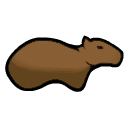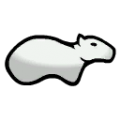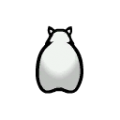Difference between revisions of "Capybara"
m (→Nutrition) |
|||
| (3 intermediate revisions by 3 users not shown) | |||
| Line 11: | Line 11: | ||
| filth rate = 8 | | filth rate = 8 | ||
| herdanimal = true | | herdanimal = true | ||
| + | | combatPower = 45 | ||
| bodysize = 0.75 | | bodysize = 0.75 | ||
| healthscale = 0.7 | | healthscale = 0.7 | ||
| Line 62: | Line 63: | ||
== Analysis == | == Analysis == | ||
| − | Capybaras are one of many animals that exist to be hunted, or be [[manhunter]]s, and not much else. They are otherwise outclassed by [[alpaca]]s | + | Capybaras are one of many animals that exist to be hunted, or be [[manhunter]]s, and not much else. They are otherwise outclassed by [[alpaca]]s. |
=== Nutrition === | === Nutrition === | ||
| − | When slaughtered, a capybara yields {{#vardefineecho:baby_meat|{{Meat Leather Curve|{{#expr:{{P|Body Size}}*0.2*140}}}}}} meat and {{Meat Leather Curve|{{#expr:{{P|Body Size}}*0.2*40}}}} leather as a baby; {{Meat Leather Curve|{{#expr:{{P|Body Size}}*0.5*140}}}} meat and {{Meat Leather Curve|{{#expr:{{P|Body Size}}*0.5*40}}}} as a juvenile; or {{Meat Leather Curve|{{#expr:{{P|Body Size}}*140}}}} meat and {{Meat Leather Curve|{{#expr:{{P|Body Size}}*40}}}} leather as an adult. | + | When slaughtered, a capybara yields {{#vardefineecho:baby_meat|{{Meat Leather Curve|{{#expr:{{P|Body Size}}*0.2*140}}}}}} meat and {{Meat Leather Curve|{{#expr:{{P|Body Size}}*0.2*40}}}} leather as a baby; {{Meat Leather Curve|{{#expr:{{P|Body Size}}*0.5*140}}}} meat and {{Meat Leather Curve|{{#expr:{{P|Body Size}}*0.5*40}}}} as a juvenile; or {{Meat Leather Curve|{{#expr:{{P|Body Size}}*140}}}} meat and {{Meat Leather Curve|{{#expr:{{P|Body Size}}*40}}}} leather as an adult. 1 meat is equal to 0.05 nutrition. |
An adult capybara consumes {{P|Real Hunger Rate}} nutrition per day, and creates up to {{#expr: {{P|Average Offspring Per Birth}}/{{P|Gestation Period Days}} round 2}} offspring per day. | An adult capybara consumes {{P|Real Hunger Rate}} nutrition per day, and creates up to {{#expr: {{P|Average Offspring Per Birth}}/{{P|Gestation Period Days}} round 2}} offspring per day. | ||
| Line 78: | Line 79: | ||
== Health == | == Health == | ||
| − | {{Animal Health Table}} | + | {{Animal Health Table|QuadrupedAnimalWithPaws}} |
== Gallery == | == Gallery == | ||
Latest revision as of 01:02, 16 July 2024
Capybara
The largest natural rodent, the capybara is well-adapted for steaming jungle environments.
Base Stats
- Type
- Animal
- Flammability
- 70%
Pawn Stats
- Combat Power
- 45
- Move Speed
- 3.9 c/s
- Health Scale
- 70% HP
- Body Size
- 0.75
- Mass - Baby
- 9 kg
- Mass - Juvenile
- 22.5 kg
- Mass - Adult
- 45 kg
- Carrying Capacity
- 56 kg
- Filth Rate
- 8
- Hunger Rate
- 0.36 Nutrition/Day
- Diet
- herbivorous
- Life Expectancy
- 12 years
- Manhunter Chance
- 0%
- Manhunter Chance (Taming)
- 0%
- Trainable Intelligence
- None
- Wildness
- 75%
- Minimum Handling Skill
- 7
- Roam Interval
- 2 days
- Mate Interval
- 12 hours
- Maturity Age
- 0.333 years (20 days)
- Juvenile Age
- 0.2 years (12 days)
- Comfortable Temp Range
- -10 °C – 50 °C (14 °F – 122 °F)
Production
- Meat Yield
- 105
 capybara meat
capybara meat - Leather Yield
- 33
 lightleather
lightleather - Gestation Period
- 5.661 days
- Offspring Per Birth
- 1-2 (1.25 avg)
Melee Combat
- Attack 1
- Front left paw
8.4 dmg (Scratch)
13 % AP
2 second cooldown - Attack 2
- Front right paw
8.4 dmg (Scratch)
13 % AP
2 second cooldown - Attack 3
- Teeth
8.5 dmg (Bite)
13 % AP
2 second cooldown
0.7 chance factor - Attack 4
- Head
4 dmg (Blunt)
6 % AP
2 second cooldown
0.2 chance factor - Average DPS
- 2.27
- tradeTags
- AnimalUncommon
Capybaras are difficult to tame herbivores.
Obtaining[edit]
Capybaras can be found in tropical rainforests and tropical swamps only. They can either be tamed by a handler or self-tame in a random event.
Capybaras can be bought and sold in other faction bases and from exotic goods traders. Capybaras purchased from traders will be already tamed.
Summary[edit]
Capybaras are pen animals. Once tamed, pen animals cannot and do not need to be trained any further. But if left outside of a pen or caravan hitching spot, pen animals will eventually roam outside your colony. Making a caravan is not required to tie animals to a caravan hitching spot.
Analysis[edit]
Capybaras are one of many animals that exist to be hunted, or be manhunters, and not much else. They are otherwise outclassed by alpacas.
Nutrition[edit]
When slaughtered, a capybara yields 26 meat and 15 leather as a baby; 53 meat and 21 as a juvenile; or 105 meat and 33 leather as an adult. 1 meat is equal to 0.05 nutrition.
An adult capybara consumes 0.36 nutrition per day, and creates up to 0.22 offspring per day.
- When offspring are slaughtered as babies, a female capybara will produce 0.29 nutrition of meat per day, giving a nutrition efficiency of 79.7%.
- If the offspring are allowed to grow to adulthood, they will consume an additional 0.86 nutrition per day, but will instead yield 1.16 nutrition per day as they are slaughtered, resulting in a nutrition efficiency of 95.1%.
When considering a population of equal numbers of males and females, these nutrition efficiencies fall to 39.9% for baby slaughter and 73.4% for adult slaughter.
Capybaras are strictly inferior for meat (per unit hunger) than both alpacas and chinchillas, both which can be found in tropical biomes. Alpacas can be sheared for wool and are pack animals, while chinchilla fur is a much more valuable trade good. Alpacas are easier to tame, and come in herds, meaning its easier to get a breeding pair of them.
Training[edit]
This animal can be trained as follows:
| Guard: | |
|---|---|
| Attack: | |
| Rescue: | |
| Haul: | |
*As of version 1.1.2610, all animals can be tamed. The percentage of likelihood of success depends on factors such as the Animals Wildness Percentage, Pawn Handling Skill, and others. More information can be found on the animals page.
Health[edit]
| Part Name | Health | Quantity | Coverage[1] | Target Chance[2] | Subpart of | Internal | Capacity[3] | Effect if Destroyed/Removed |
|---|---|---|---|---|---|---|---|---|
| Body | 28 | 1 | 100% | 26% | N/A[4] | - | Death | |
| Spine | 17.5 | 1 | 3% | 3.0% | Body | Moving |
−100% Moving[5] | |
| Stomach | 14 | 1 | 3% | 3.0% | Body | Digestion |
−50% Digestion | |
| Heart | 10.5 | 1 | 3% | 3.0% | Body | Blood Pumping |
Death | |
| Lung | 10.5 | 2 | 3% | 3.0% | Body | Breathing |
−50% Breathing. Death if both lost | |
| Kidney | 10.5 | 2 | 3% | 3.0% | Body | Blood Filtration | −50% Blood Filtration. Death if both lost | |
| Liver | 14 | 1 | 3% | 3.0% | Body | Digestion |
Death | |
| Neck | 17.5 | 1 | 22% | 22% | Body | Eating Talking Breathing |
Death | |
| Head | 17.5 | 1 | 75% | 9.9% | Neck | - | Death | |
| Skull | 17.5 | 1 | 25% | 1.2375% | Head | - | Cannot be destroyed Increasing Pain based on damage. | |
| Brain | 7 | 1 | 70% | 2.8875% | Skull | Consciousness |
Death Damage always results in scarring. | |
| Eye | 7 | 2 | 12% | 0.495% | Head | Sight |
−25% Sight. −100% if both lost. Damage always results in scarring. 0% Hit Chance against Blunt damage. | |
| Ear | 8.4 | 2 | 8% | 0.33% | Head | Hearing |
−25% Hearing. −100% if both lost. −15 Disfigured Social penalty | |
| Nose | 7 | 1 | 10% | 0.4125% | Head | - | −15 Disfigured Social penalty | |
| AnimalJaw | 7 | 1 | 10% | 0.4125% | Head | Manipulation |
−100% Manipulation. Can no longer use Bite attack. | |
| Front Leg | 21 | 2 | 7% | 5.95% | Body | Moving |
−25% Moving. −50% if both lost. Can no longer use paw attack[6] | |
| Front Paw | 7 | 2 | 15% | 1.05% | Front Leg | Moving |
−25% Moving. −50% if both lost. | |
| Rear Leg | 21 | 2 | 7% | 5.95% | Body | Moving |
−25% Moving. −50% if both lost | |
| Rear Paw | 7 | 2 | 15% | 1.05% | Rear Leg | Moving |
−25% Moving. −50% if both lost |
- ↑ Coverage determines the chance to hit this body part. It refers to the percentage of the super-part that this part covers, before its own sub-parts claim their own percentage. For example, if the base coverage of the super-part is 100%, and the coverage of the part is 20%, 20% of hits would hit the part, and 80% the super-part. If the part had its own sub-part with 50% coverage, the chances would be 10% sub-part, 10% part, 80% super part.
- ↑ Target Chance is the actual chance for each part to be be selected as the target when each part's coverage has been taken into account(I.E. Neck covers 7.5% of Torso but Head covers 80% of Neck so it actually has only a 1.5% chance to be selected). This is not pure hit chance, as different damage types propagate damage in different ways. See that page for details.
- ↑ Note that capacities can affect other capacities in turn. Only the primary effect is listed. See specific pages for details.
- ↑ This is the part that everything else connects to to be considered 'connected'.
- ↑ If Moving drops below 16% a pawn cannot move.
- ↑ A Scratch attack that varies from animal to animal. Each front paw allows one attack.
Gallery[edit]
Version history[edit]
- 0.12.906 - Added




